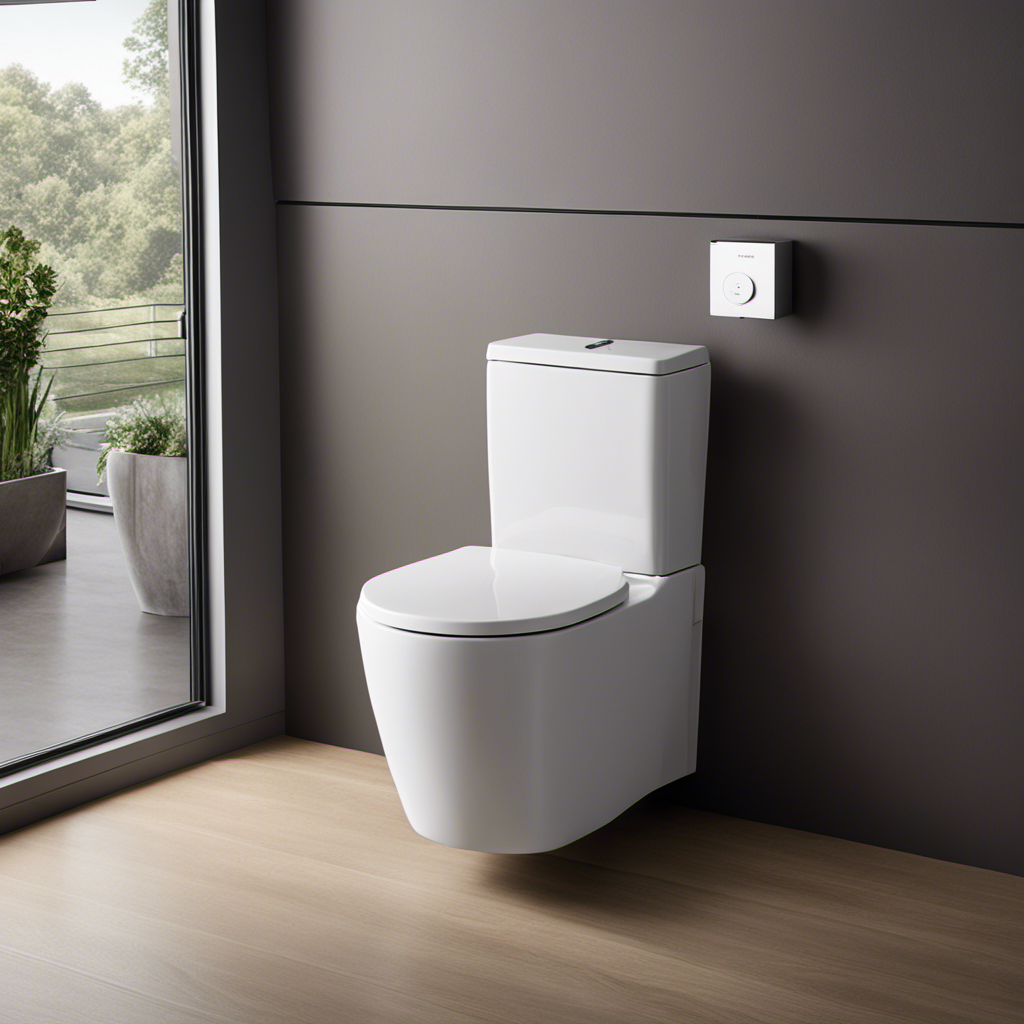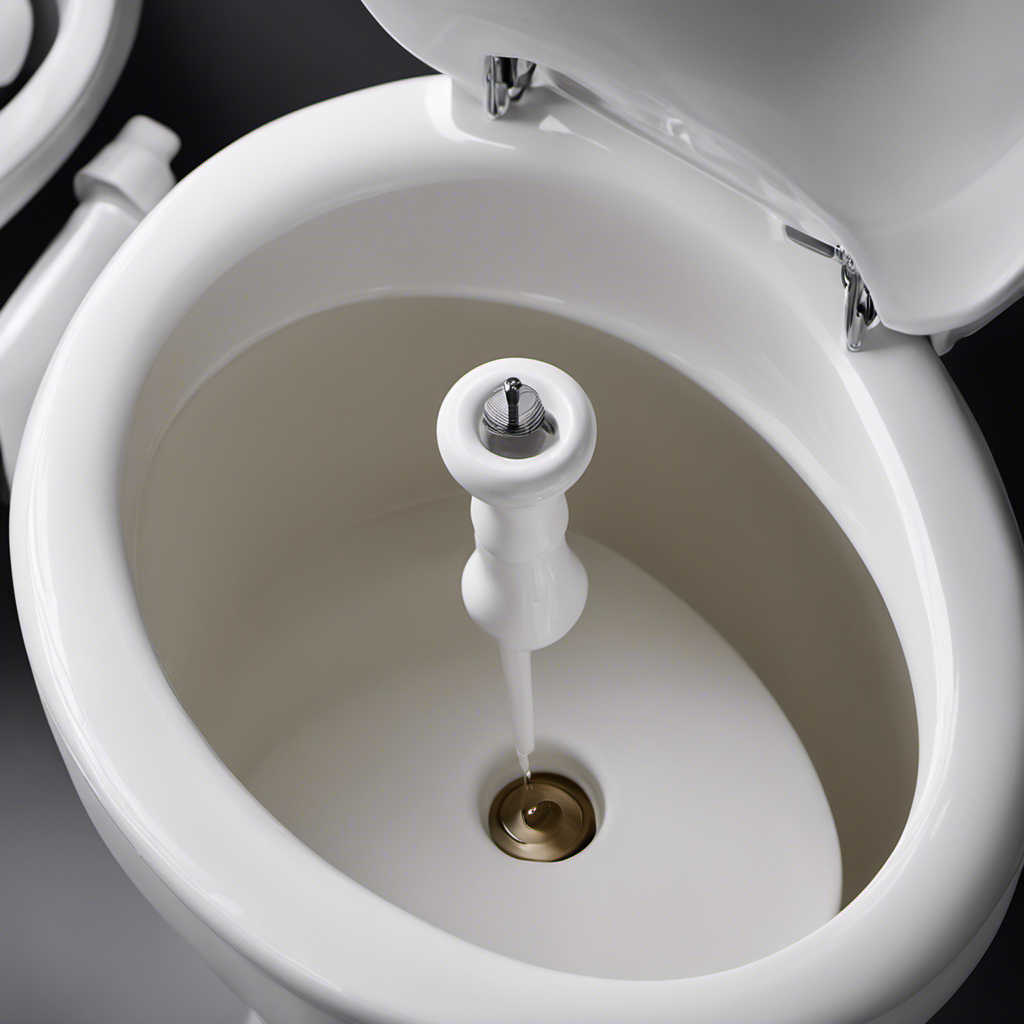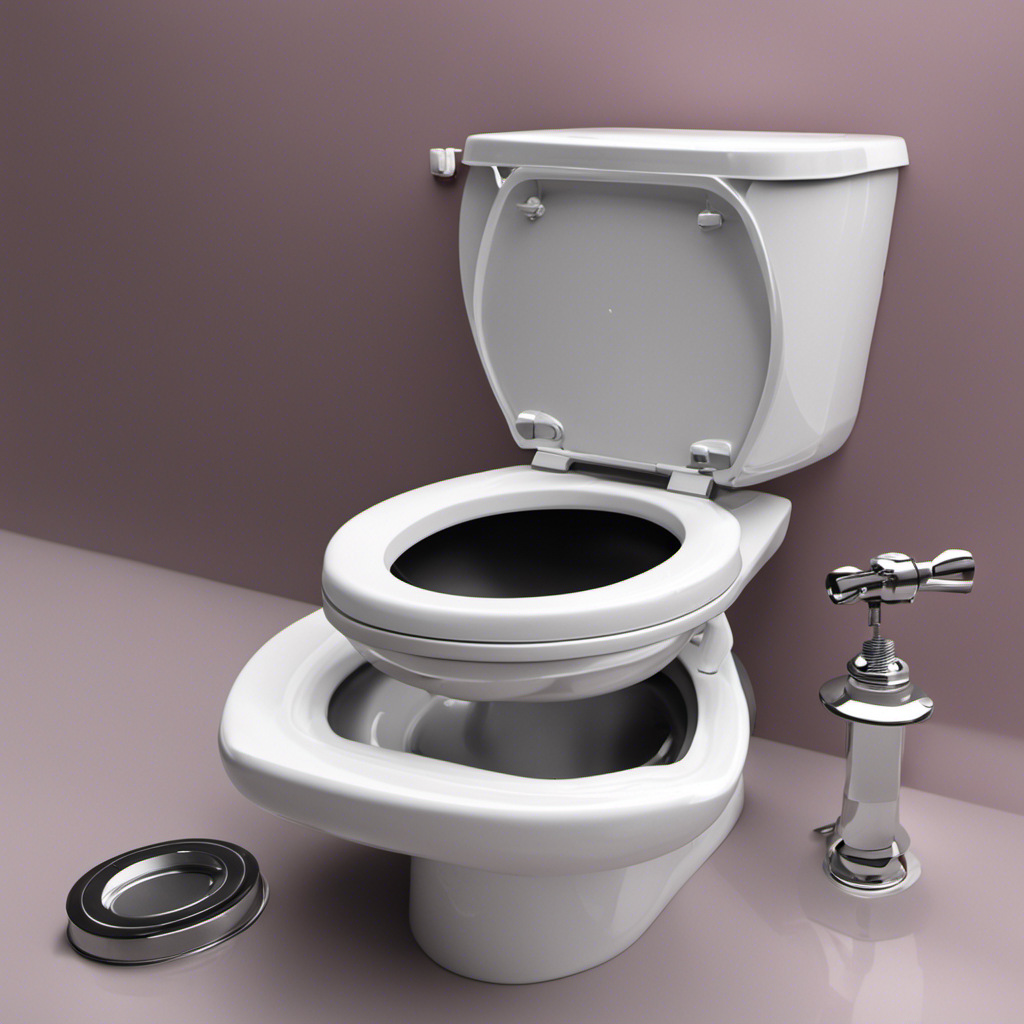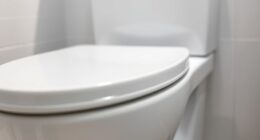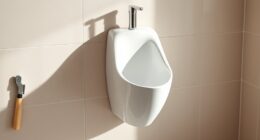Have you ever wondered how you can add a toilet to your basement or an area with no existing plumbing? Well, let me introduce you to the game-changer: the upflush toilet.
This innovative solution allows you to install a toilet virtually anywhere, without the need for costly and time-consuming plumbing work. In this article, I will guide you through the benefits, working mechanism, installation process, and maintenance tips for upflush toilets.
Get ready to revolutionize your bathroom experience!
Key Takeaways
- Upflush toilets can be installed in any location without existing plumbing, making them ideal for areas like basements and garages.
- They save on installation costs and allow for flexibility in floor plan design.
- Upflush toilets use a macerator pump to break down waste and pump it upwards, eliminating the need for extensive plumbing work.
- Regular maintenance and inspection of the macerator pump is necessary to ensure smooth operation.
Benefits of an Upflush Toilet
One of the benefits of an upflush toilet is that it can be installed in any location, even without existing plumbing. This advantage makes it an ideal solution for basements, garages, or other areas where traditional plumbing is not easily accessible.
The upflush toilet uses a macerating system to break down waste and pump it up to the main drain line, eliminating the need for expensive and time-consuming plumbing installations. Not only does this save on installation costs, but it also allows for flexibility in floor plan design.
In terms of cost comparison, the upflush toilet may have a higher upfront cost compared to a traditional toilet, but the savings in plumbing installation and the ability to install it in any location make it a cost-effective choice in the long run.
How an Upflush Toilet Works
To understand how an upflush toilet works, it’s important to know that it uses a macerator pump to break down waste and pump it upwards. This pump is typically located behind the toilet and consists of sharp blades that grind up solid waste, allowing it to be easily transported through small pipes. The macerator pump then pushes the waste upwards to the main sewage line or septic tank.
There are several advantages to using an upflush toilet. First, it eliminates the need for extensive plumbing work, making it a cost-effective option for adding a bathroom in a basement or other areas below the main sewer line. Second, it allows for flexibility in bathroom placement, as it can be installed virtually anywhere.
However, there are also some disadvantages to consider. The macerator pump can be noisy, especially when it kicks in to grind up waste. Additionally, maintenance and repairs can be more complicated compared to traditional toilets. It’s important to regularly clean and maintain the macerator pump to prevent clogs and ensure proper functionality.
Despite these drawbacks, upflush toilets offer a convenient solution for adding a bathroom in unconventional spaces.
Installation Process of an Upflush Toilet
When installing an upflush toilet, you’ll need to ensure that the macerator pump is securely positioned behind the toilet. This pump is responsible for grinding and pumping the waste from the toilet to the main sewer line or septic tank.
The installation process of an upflush toilet can be somewhat complex, but with the right tools and knowledge, it can be done successfully. Here are the steps involved in the installation process:
-
Prepare the area: Clear the space where the toilet will be installed and ensure that the floor is level.
-
Install the macerator pump: Securely attach the macerator pump behind the toilet, making sure all connections are tight.
-
Connect the water supply: Install the water supply line to the toilet tank, ensuring a proper seal.
-
Test the system: Fill the toilet tank with water and flush to ensure that the macerator pump is functioning correctly.
Overall, the installation process of an upflush toilet requires careful attention to detail and may require professional assistance. When considering the installation, it is also important to conduct a cost analysis, as upflush toilets can be more expensive than traditional toilets due to the additional components and plumbing requirements.
Maintenance Tips for Upflush Toilets
Make sure you regularly clean and inspect the macerator pump to ensure it’s working properly. The macerator pump is a crucial component of an upflush toilet system. Over time, debris and waste can accumulate in the pump, leading to clogs and reduced performance.
Cleaning the pump involves removing any obstructions and cleaning the blades to ensure smooth operation. In addition to regular cleaning, it’s important to be aware of common problems that can arise with upflush toilets.
One common issue is a leak in the seal between the toilet bowl and the macerator unit. This can result in water leakage and unpleasant odors. Troubleshooting techniques for this problem include checking the seal for damage and replacing it if necessary.
Another common problem is a malfunctioning float switch, which can cause the pump to run continuously or not turn on at all. Troubleshooting this issue involves checking the switch for proper operation and replacing it if needed.
Comparing Upflush Toilets to Traditional Toilets
Comparing upflush toilets to traditional toilets, it’s important to consider factors such as installation cost, maintenance requirements, and overall efficiency.
-
Cost Comparison:
-
Upflush toilets may have a higher upfront cost due to the additional components required for their installation, such as a macerator and pump. However, they can be more cost-effective in the long run as they eliminate the need for extensive plumbing work.
-
Traditional toilets have a lower initial cost, but may require costly plumbing modifications if the existing infrastructure is not suitable.
-
Environmental Impact:
-
Upflush toilets use water-efficient flushing systems, reducing water consumption and promoting sustainability.
-
Traditional toilets can be wasteful, using excessive amounts of water per flush and contributing to water scarcity issues.
Considering both cost and environmental impact, upflush toilets offer a modern and efficient solution that not only saves money but also helps protect our precious water resources.
Frequently Asked Questions
Are Upflush Toilets Suitable for All Types of Plumbing Systems?
Yes, upflush toilets are suitable for all types of plumbing systems. Their installation flexibility allows them to be easily added to existing plumbing without the need for major renovations or expensive reconfigurations.
Can an Upflush Toilet Be Installed in Any Room of the House?
Yes, an upflush toilet can be installed in any room of the house, as long as the installation requirements are met. It offers benefits like flexibility and convenience, but drawbacks include noise and potential maintenance issues.
How Loud Is the Flushing Process of an Upflush Toilet?
The flushing process of an upflush toilet can be surprisingly quiet, thanks to its innovative design. It requires minimal space, making it ideal for basements. The advantages of using one in a basement include easy installation and flexibility in location.
Can an Upflush Toilet Handle Solid Waste as Effectively as a Traditional Toilet?
Yes, an upflush toilet can handle solid waste as effectively as a traditional toilet. The advantage of upflush toilets is that they require less maintenance and can be installed in places where traditional plumbing is difficult.
Are There Any Limitations to the Amount of Water an Upflush Toilet Can Handle?
There are limitations to the amount of water an upflush toilet can handle. However, the benefits of using upflush toilets, such as their ability to handle solid waste effectively, outweigh these limitations.
Conclusion
In conclusion, the upflush toilet offers a multitude of benefits that traditional toilets simply cannot match. With its innovative design and efficient functionality, it brings convenience and flexibility to any space.
The installation process, although technical, is worth the effort for the ease it provides. And let’s not forget about the low maintenance requirements, making it a reliable choice for any homeowner.
When comparing upflush toilets to their traditional counterparts, the choice is clear – the upflush toilet reigns supreme.
